This leaflet provides information about exercises patients should follow at home if they have been diagnosed with intermittent claudication.

Home exercise programme
These exercises can be done up to three times a week as part of your exercise programme.
Completing them all should take around 30 minutes and will count as one of your weekly exercise sessions. They should be performed in a controlled manner, paying attention to correct posture and technique throughout.
When not to exercise
If you feel unwell with any of the following, take a rest day and do not return to exercise until you feel better:
- A bad cold, flu, a high temperature, feeling very tired or generally.
- Feeling unwell
- Any injury to a muscle or joint
- Acute episode of arthritis in ankles knees or hips.
Stop immediately if while exercising you experience:
- Chest pain
- Dizziness
- Extreme shortness of breath.
Please contact your GP or vascular nurse to check if it is okay for you to continue with your home exercise programme.
If you experience chest pains or extreme shortness of breath that does not go away when you stop exercising, please call an ambulance.
Before you start
- Wear comfortable clothes and supportive footwear.
- Prepare a space and clear any trip hazards.
- You will need a sturdy high-backed chair and a glass of water for when you finish.
Posture
- Sit or stand tall, with your feet hip width apart and pointing forward.
- Ensure your chin is parallel to the floor.
- Drop your shoulders down and back.
- Lift your rib cage and draw your navel towards your backbone.
- Imagine length through the spine and neck.
- Drop your tail bone down.
- Try to maintain this posture throughout your exercise session.
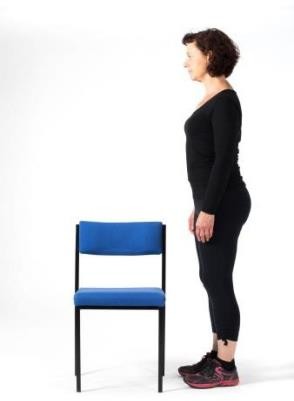
Warming up
There are four warming up exercises. They aim to gently warm your muscles and joints and promote circulation.
- Stand (or sit) tall.
- If you feel unsteady hold the back of the chair.
- March your feet and allow your arms to swing in an easy natural rhythm.
- Continue for 30 seconds. Rest and repeat four more times.
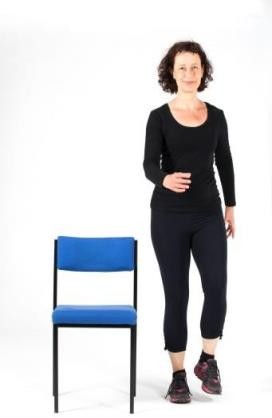
- Stand (or sit) tall with your arms by your side.
- Gently roll your shoulders forwards, then up to your ears and then back and down.
- Keep the movement fluid (relaxed).
- Repeat five times.
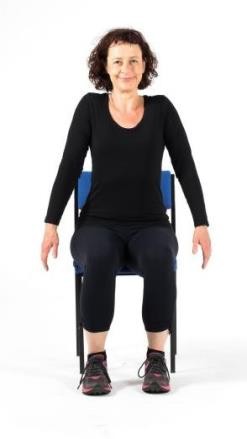
- Stand tall (or sit tall at the front edge of the chair).
- Hold the back (or sides) of the chair.
- Place the heel of one foot on the floor then lift it and put the toes down on the same spot.
- Repeat five times on each ankle.
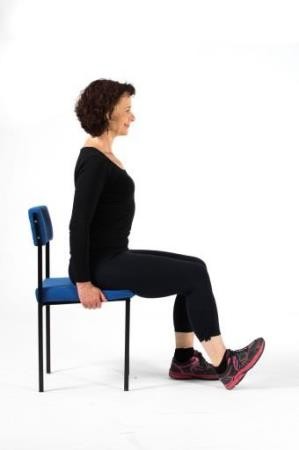
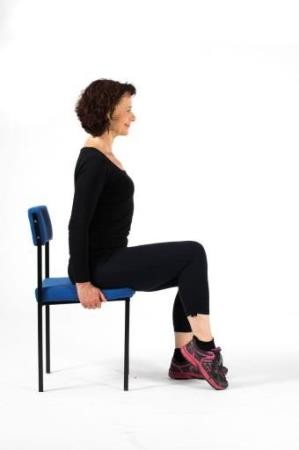
- Stand (or sit) very tall with your feet hip-width apart.
- Fold your arms across your chest.
- Twist your upper body and head to the right keeping your hip forward (try to turn from the waist).
- Repeat on the opposite side.
- Repeat this five times on for each side.
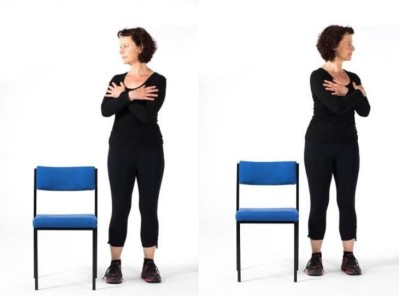
Main exercise
The pain you experience in your legs when you walk or exercise actually stimulates your body to grow new blood vessels; this is called collateral circulation. Because of this it is important to keep repeating each of these main exercises until your leg muscles are really aching. Try to keep going until the pain is moderate to severe or between 4/5 on the claudication pain scale.
Claudication pain scale:
- No pain 1
- Onset of pain 2
- Mild pain 3
- Moderate pain 4
- Severe pain 5
At this point stop and rest until the pain has completely subsided before moving on to the next exercise. This stop-start approach will really help to improve your circulation.
There are 14 exercises; try to complete them all.
- Stand tall holding your support, feet parallel and slightly narrower than hip-width apart.
- Raise your heels off the ground taking your weight over your big toe and ball of your foot.
- Lower your heels with control.
- Continue for two minutes or until you reach 4 to 5 on the pain scale.
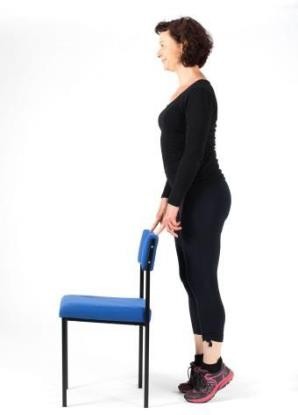
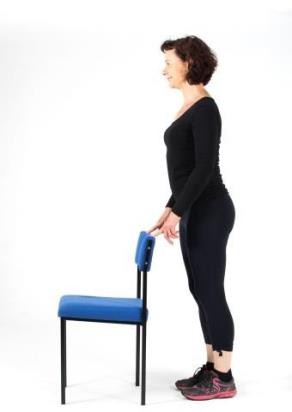
- Stand tall, side on to your support.
- Keep your chest lifted as you lift alternating knees up.
- Do not lift any higher than hip level.
- Continue for two minutes or until you reach 4 to 5 on the pain scale.
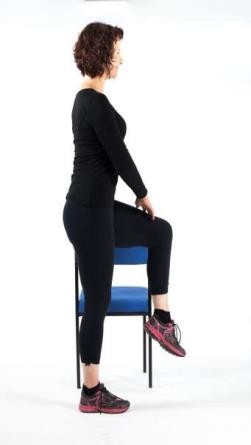
- Stand tall facing your support.
- Take a sideways step to the right and then to the left.
- Repeat side to side building to a comfortable rhythm.
- Continue for two minutes or until you reach 4 to 5 on the pain scale.
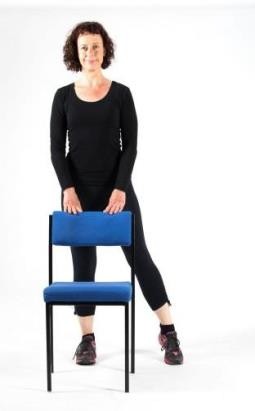
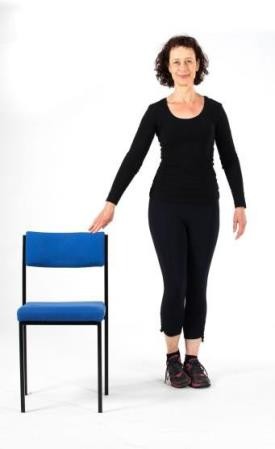
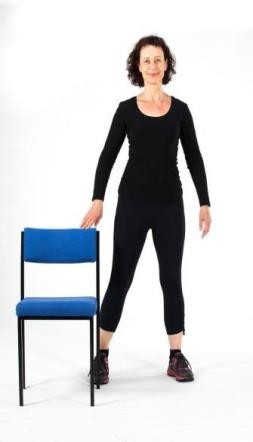
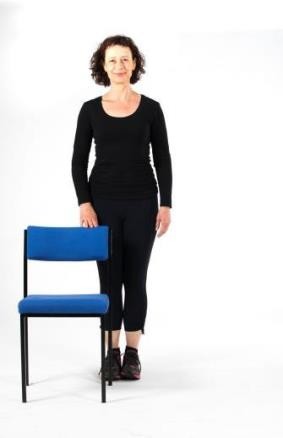
- Stand tall in front of a low step.
- Starting with your most affected leg, step up onto the step with both feet and then down again.
- Continue for two minutes or until you reach 4 to 5 on the pain scale.
- Repeat, leading with the other leg.
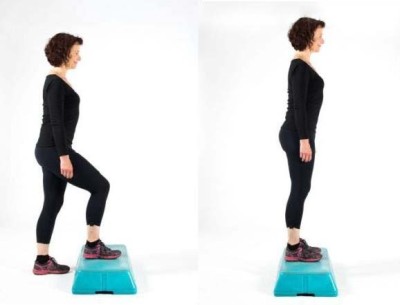
- Stand tall and side on to your support.
- Raise your heels off the ground keeping the weight over your big toe and ball of the foot.
- Take 10 small steps forwards.
- Bring your feet together then lower your heels with control.
- Repeat in the other direction.
- Continue for two minutes or until you reach 4 to 5 on the pain scale.
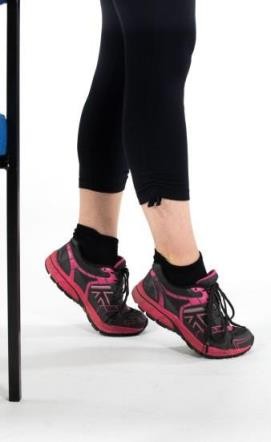
- Sit tall near the front edge of the chair.
- Place your feet hip width apart and slightly back.
- Lean forwards slightly.
- Place your hands on your thighs and prepare to stand in one swift powerful movement, then push through your leg muscles and stand up.
- Step back until your legs touch the chair and slowly lower your bottom back into the chair.
- Repeat 10-20 times or until you reach 4 to 5 on the pain scale.
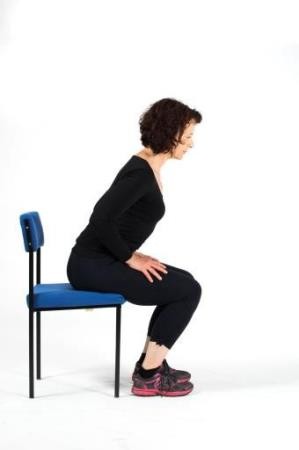
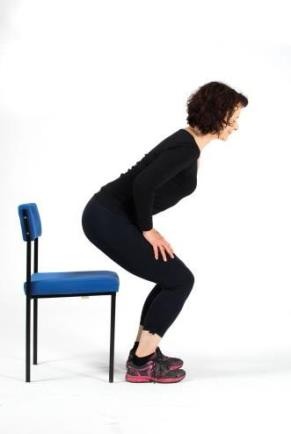
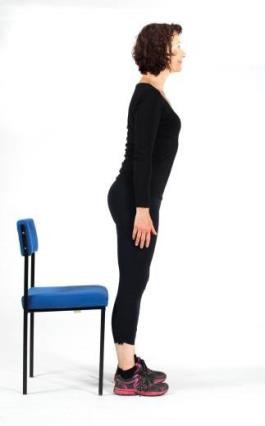
- Find a space to walk up and down – this could be a corridor, landing or even out in the garden.
- Walk back and forth for two minutes or until you reach 4 to 5 on the pain scale.
- Sit with your back supported by the chair back.
- Straighten one leg so the foot is held off the floor and the thigh muscles are tight.
- Hold for a count of five, then lower foot to the floor.
- Repeat 5-10 times on each leg.
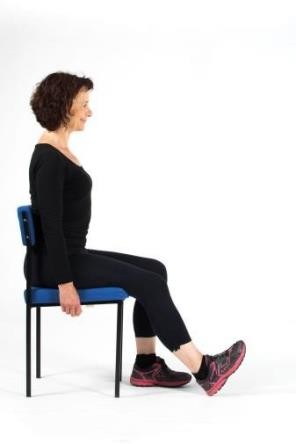
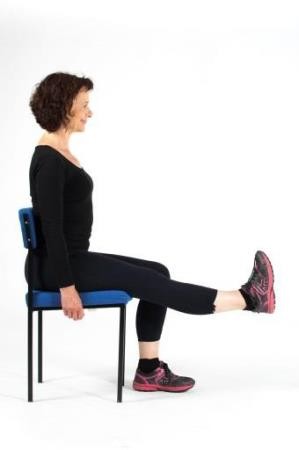
- Stand tall holding your support.
- Raise your toes taking your weight back into your heels without sticking your bottom out.
- Hold for a second then lower your toes with control.
- Continue for two minutes or until you reach 4 to 5 on the pain scale.
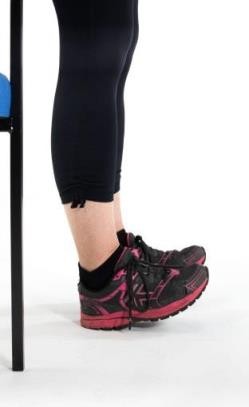
- Stand tall facing your support.
- Take 10 sideways steps to the right keeping your hips forward and knees relaxed.
- Repeat to the left.
- Continue for two minutes or until you reach 4 to 5 on the pain scale.
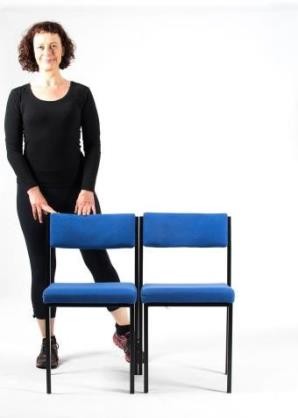
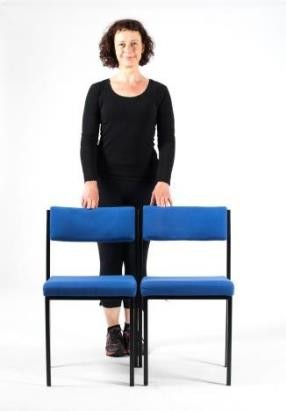
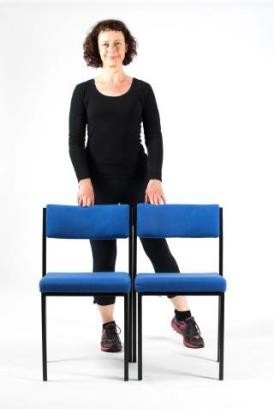
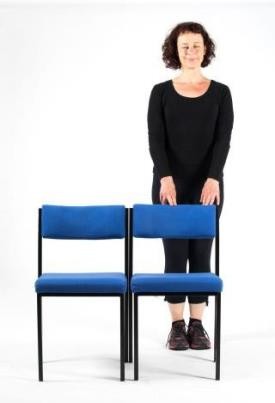
- Hold the rail if you usually do but try not to pull too much with your arms.
- Use your strongest leg to lead on each step.
- Place your foot fully on the stair.
- Look down with your eyes (rather than bending forward from the waist) to check the position of your foot.
- At the top, take a rest then come back down leading with your weaker leg on each step.
- Repeat for two minutes or until you reach 4 to 5 on the pain scale.
- Stand tall and side on to your support.
- Raise your toes without sticking your bottom out take 10 small steps forwards. Lower your toes with control.
- Repeat in the other direction.
- Repeat for two minutes or until you reach 4 to 5 on the pain scale.
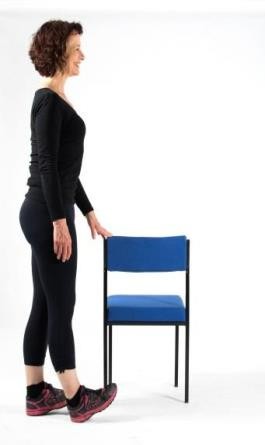
- Sit tall near the front of the chair with your feet and knees touching, then wrap the band around your legs (keeping the band as flat as possible).
- Push your knees outwards, keeping your feet flat on the floor and hold for a slow count of five.
- Release, then repeat 10 more times or until you reach 4 to 5 on the pain scale.
- To make the exercise a little harder, take your feet and knees to hip width apart.
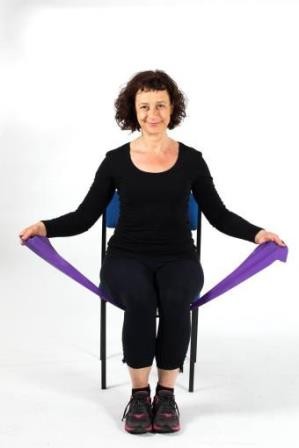
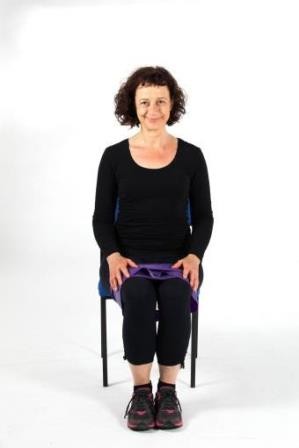
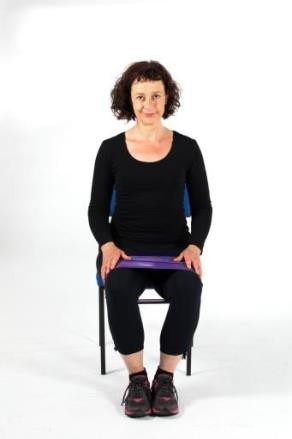
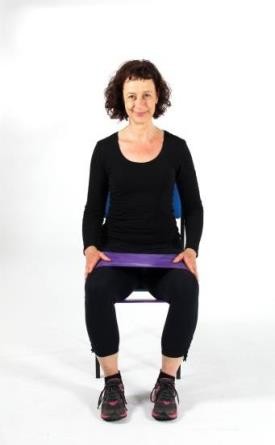
Finish by marching at a relaxed pace for one to two minutes then perform all the following stretches:
Chest stretch
- Sit tall away from the back of the chair and place both hands on your bottom.
- Gently draw your shoulder blades together until you feel a stretch across the front of your chest. Hold for 10 seconds and then release.
- Repeat twice.
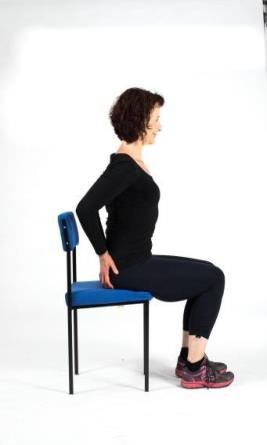
Back of thigh stretch
- Sit tall on the front third of the chair, shoulders down and tummy in.
- Straighten one leg placing the heel on the floor.
- Place both hands on the other leg and lengthen upwards through your spine.
- Lean forwards with a straight back until you feel the stretch in the back of your thigh. Hold for 10-20 seconds.
- Repeat on the other leg.
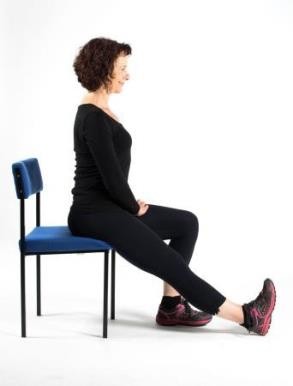
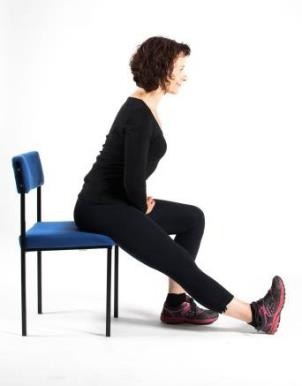
Calf stretch
- Stand behind the chair holding on with both hands and step back with your right leg, pressing the heel down.
- Check that both feet face directly forwards.
- Bend the left knee and feel the stretch in your right calf. Hold for 10-20 seconds.
- Repeat on the other leg.
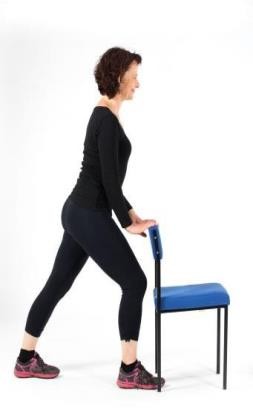
 Translate
Translate